Now live: The 2025 Canopy Report. Learn how Americans see trees. GET THE REPORT
Replanting Paradise: On the Ground with Kieran O'Leary
The Arbor Day Foundation spoke with California forester Kieran O'Leary following the 2018 Carr and Camp Fires.
October 14, 2020

Some of the best ways to fight forest fires are with trees.
Properly spaced trees cut back on fuel for forest fires and the presence of forests also prevent soil erosion, which leads to flooding and mudslides.
The forests in California and the Northwest are overstocked, according to Kieran O'Leary, a registered professional forester with more than 25 years of experience working in the state of California.
“Three words: spacing, spacing and spacing,” he told the Arbor Day Foundation. “Right now, there are too many trees per acre. Where we need to get back to is levels that were 100, possibly 150 years ago, where the stocking levels would be anywhere from 30 to 50 trees per acre. Initially, after replanting these fires here in California, a lot of times we would plant 300 trees per acre, and we’re finding out that that's too much.”
Essentially, the overstocked forests act as fuel for the fires.
O'Leary, 54, has been helping prevent forest fires since he graduated from the University of California, Berkeley in 1989. He worked for a large timber company and also worked for a small consulting firm. At present, he is employed by a utility company that is involved in removing hazard trees in the Paradise and Magalia area, outside of Chico, after the Camp Fire of November 2018.
Responding to Historic Loss
In the second half of 2018, more than 8,000 fires burned across the state burning nearly 2 million acres of forestland. Just five of those fires combined to destroy more than 22,000 structures — including O’Leary and his wife’s home — and kill at least 98 people. Losses and damages were estimated to be account for more than $1 billion.
The Arbor Day Foundation responded with the California Wildfire Restoration Project by convening its partners to plant 2 million trees on private land.
Since Jan. 1 of this year, California has had about 6,500 fires, affecting nearly 2.25 million acres, according to the California Dept. of Forestry and Fire Protection (CAL FIRE).
At ground level, it’s easy to see that the intensity of the fires grows from year to year, O’Leary said, especially with the fires that are currently ravaging northern California.
This year, the Arbor Day Foundation is planting 100-150 trees per acre. He said it is important as the trees grow and develop and some of them die off to not only maintain the health of the new trees but also controlling the grass and the brush at the base of the trees.
“We need to manage our forest more on a landscape level rather than spots here and there,” O’Leary said. “It's a huge endeavor because it crosses property lines, whether it's the Forest Service, Bureau of Land Management or private- and small landowners. We all have to get on that same page.
“Once we re-establish these forests, we have to manage them and keep their fuel reduction low so that we can reduce these megafires in the future.”
O’Leary suggested a “mixed bag pf prescriptions” to help prevent megafires such as reintroducing prescribed burning, grazing and even using herbicides to control the underbrush.
“The other alternative is what we've been witnessing for the past few weeks,” he said. “Mother Nature will clear it out for us — and in a hurry.”
© Arbor Day Foundation | Forest lands damaged by wildfires in Northern California
Recovery in the Long-Term
In the absence of trees, rainstorms in California easily erode the soil and cause tremendous damage to the terrain, O’Leary said. Once soil — the “building block” for re-establishing forests — is washed away, trees don’t have anywhere to grow or produce.
“We need to keep that soil in place,” he said.
O’Leary emphasized that restocking the forests to the levels of even 50-60 years ago can go a long way to winning the fight against megafires. It’s going to take some work because of the forests cut across public and private property lines.
“But once we can get that implemented, we can turn the tide and get away from these megafires to the point where if we do get something like we did back last month, where we have a thousand lightning strikes through the state of California, then these fires are smaller and less intense and more manageable,” he said. “So, a good way to control this situation is to just to keep spacing the trees and have a better control of what the forest looks like in the first place.”
© Arbor Day Foundation | Planting crews at work on private lands in California
Moving Forward in 2020
“The current fires did not have an impact on our planting projects for next year,” O’Leary said. “For our Camp Fire projects, the seedling sowing orders were placed in fall of 2019. The seedlings will be lifted from the nurseries in November and put into cold storage. We plan on planting the seedling in the field in February.”
For the projects he works on, the planning horizon is 27-30 months from the initial fire date (for the Camp Fire, Nov. 8, 2018) until seedlings are planted in the field.
“Typical private industry timelines can reduce that length of time down to 18 months, if a seedling order is placed a few months after a fire,” O’Leary said. “The advantage of planting soon after a fire is that there is less competing brush and vegetation for the seedlings. The longer you wait for planting, the more your vegetation control cost go up, and seedling mortality will increase as well.”
To learn more about the Arbor Day Foundation's efforts to restore forestlands devastated by wildfires, visit www.arborday.org/wildfire





